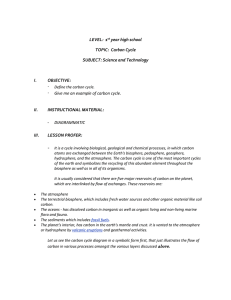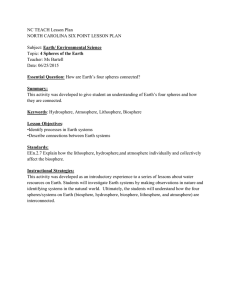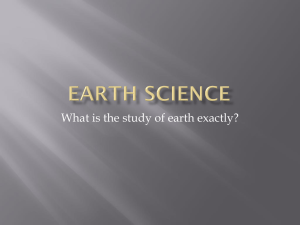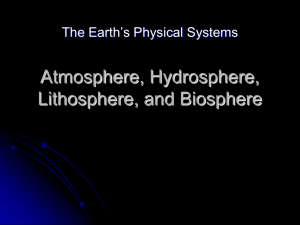http://www.eduweb.com/portfolio/earthsystems/images
advertisement
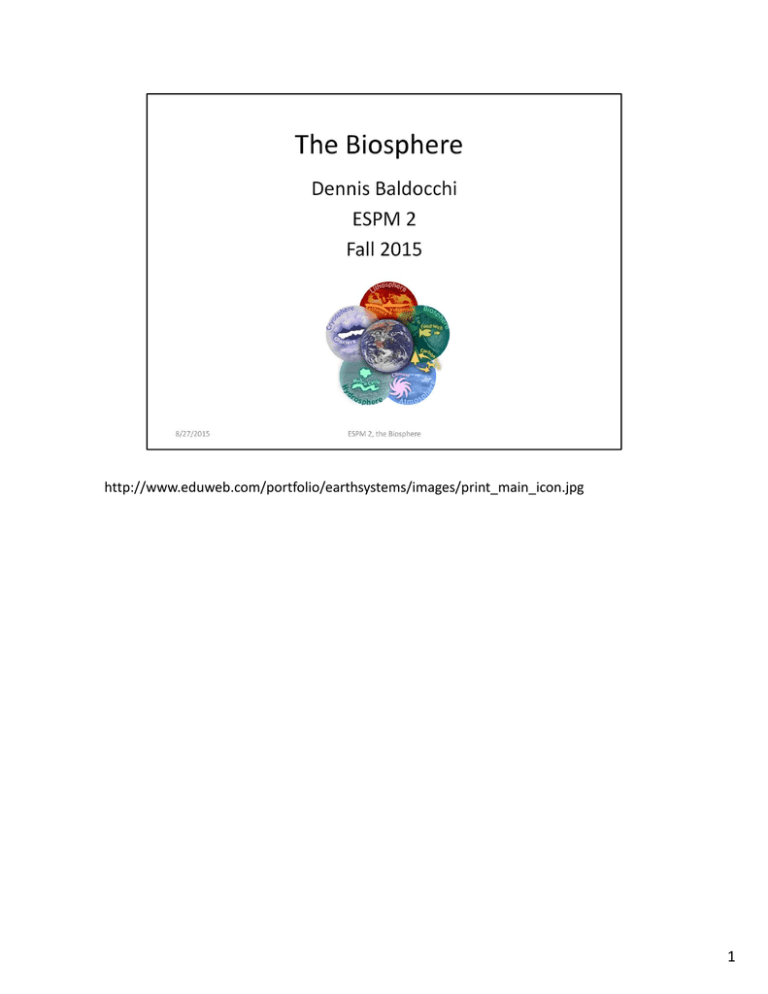
http://www.eduweb.com/portfolio/earthsystems/images/print_main_icon.jpg 1 Dictionary 2 This Blue Marble photo is another iconic view of Earth from space. What do you see in this image? Water, land, dry land, green land, clouds, swirls, snow 3 4 5 6 7 8 9 https://esw.climate.nasa.gov/wp-content/uploads/2014/09/Five-Spheres.png We can’t study the biosphere in isolation. We need to understand its connection to the other spheres of the earth system and how these all add up. What are those connected spheres. They are the lithosphere, cryosphere, atmosphere and hydrosphere. Think about Life. It needs water to hydrate, dissolve and transfer nutrients to cells and organs. It needs oxygen and carbon dioxide from the atmosphere to build life and maintain it. The atmosphere also regulates the temperature and provides water in the form of precipitation. We live on the soil and depend upon it for recycling material and anchoring plants. So you can start to see the connections. 10 11 12 Eduard Suess, Austrian geologist 13 What do we mean by this? In simple terms ‘life eats sunlight’ and takes that energy to support life and metabolism. This philosophy is at the heart of my thinking and teaching of my biometeorology and ecosystem ecology courses..how we quest to capture the energy of sun light and use it. 14 Pt 1 is why my lab measures solar radiation and tries to understand how it varies with time and across the globe Pt 2 leads us to do a considerable amount of work on the soil and the transformation of organic matter in litter and the soil back into CO2 or methane Pt 3 is the basis of trying to perform global ecology with use of satellite remote sensing and models and is behind efforts to manage the biosphere from disturbances Pt 4 is why my lab works so, so much on measuring and modeling trace gas exchange 15 16 The space age gave us an unprecedented view of Earth and was the start of recognizing its isolation and fragility. It also made us understand we are not infinite, we have borders and can affect its state. And you know it is important when the idea becomes a stamp! 17 This image gives us perspective of our role in the universe. We are just a point of light as our space ship starts to leave the solar system. We are not the center of the Universe!! Or the Solar System. We are expendable, and in time will be. So make the most of your life while on Earth! Also stresses the isolation and vulnerability of our planet. 18 19 20 The biosphere is not an isolated concept, it is connected to the atmosphere, hydrosphere and lithosphere. It affects their state and fate, and vice versa. Let’s discuss some of these feedbacks. How do plants affect the Atmosphere?; Vice Versa, etc, etc. Also note that life is effectively everywhere and inhabits these other spheres. Microbes, plankton, algae, fish, invertebrates live in the hydrosphere. Roots and microbes penetrate deep into the soil and lithosphere. The atmopshere is full of insects, birds, microbes, viruses, pollen and spores 21 22 We have to think differently when studying ecosystems and the biosphere around us. This takes us from a conventional Newtonian approach, where the world seems clocklike, to one that embraces chaos and complexity. Lessons derived here also can play roles in understanding advances in economics, climate, political science and health. We all are complex systems. Treating these systems in this manner help us understand better how to manage these systems and understand the limits of our ability to predict future states. 23 This is the list of many attributes of complex systems. I will explore these more in the following slides 24 25 http://www.msubbu.in/sp/ctrl/Rule-6.gif 26 27 28 Examples of some of the Connections we will cover over the course http://www3.geosc.psu.edu/~dmb53/DaveSTELLA/intro%20ESS/3.gif; good set of notes http://www3.geosc.psu.edu/~dmb53/DaveSTELLA/entrance.htm 29 An example is that the state of nitrous oxide in the atmosphere that is distributed globally depends on the production by microbes during denitrification. 30 Why is measuring the biosphere so hard? Actors span a huge spectrum in space scales, from the tiniest bacteria, that may be on the order of a micron; to the organelles and cells of a leaf, and how they are assembled together to form a leaf; how leaves are assembled to form a plant; how plants are assembled to form a canopy; how patches of vegetation and soil interact to form a landscape; how landscape interact to form an ecosystem; how climate and ecosystems interact to form a biome; how biomes are collected on a continent and finally, how these continents act together on the globe 31 One of the reasons I a fascinated with complexity is the idea of scale emergent properties. The whole acts differently than the sum of the parts 32 The idea, ‘scale emergent property’ may sound odd or foreign. But it is all around us. Humans are good examples of the idea of scale emergent properties 33 The melting of ice is complex and is something that needs to be factored better into global climate change models if we are to correctly predict the melting of the ice caps with warming, and understand their albedo feedbacks 34 http://www.rawfunction.com/wp-content/uploads/2012/11/The-Art-of-Clean-Up2.jpg 35 In my realm, the sum of leaves acts differently than how the whole ecosystem functions, with regards to CO2 and water vapor exchange 36 Butterfly Effect: If a butterfly flaps its wings can a Hurricane form? Idea is that complex systems are sensitive to initial conditions. The butterfly effect is often invoked. Though it may be a red herring or a fallacy as the flap of a wing is dissipated by the viscosity of the air. It does not have enough energy to perpetuate a large enough uncertainty in the variance of the wind velocity. 37 Self organized structures are everywhere in nature. So the idea of complexity is important when thinking about, interpreting and managing/perturbing the biosphere 38 Lorenz found that chaos emerged due to sensitivity to initial conditions. 39 Lorenz discovered complex behavior and sensitivity of non linear equations almost by accident. He was programming the equations of motion into an early computer. He decided to truncate the initial input for simplification and got different answers. In the early days of computer science, one was likely to blame the computer. But the computer was correct and a new science was discovered. Serendipity and brilliant insights to see something when no one else has. 40 The many feedbacks of complex systems produce robust systems, until there is a regime shift. It is my opinion that this robustness is causing society to be cavalier about global warming. The climate system has been fairly robust to our initial insults by changing greenhouse gas forcing. But ultimately, glaciers will melt, permafrost will release vast stores of methane and CO2, and we will entire a new climate state. 41 42 Networks are ubiquitous throughout the biosphere. Life needs to move material and energy to and from sources and sinks. Theory has shown that networks are the most efficient way to do this. 43 What type of river networks are possible and optimal? Why do branched networks tend to form? Branch networks are the most efficient way to move material and energy. They have the shortest integrated path and maintain a relatively short average direct path. 44 Networks and network theory are all around us. Mathematicians have borrowed the idea of neural networks, from how our brains work, to describe coupled systems that high high levels of predictability. My lab uses neural networks to predict carbon and water fluxes to and from ecosystems when direct measurements are missing and we train our neural networks with simple input information like sunlight, temperature, humidity and amount of vegetation. 45 46 47 This background is important as our management and modification of the biosphere is not simple. By ignoring the complexity of the system we are vulnerable to many unintended consequences. An example of unintended consequences? Just think about the impact of the societal choice to forsake nuclear power and instead depend upon fossil fuels to energize our societies. While the events at Chernobyl, Three Mile Island and Fukashima have indeed been terrible, many more people have died directly and indirectly due to the impacts of global warming from greenhouse gases and in the retrieving of fossil fuels from the ground. And as we study environmental change the pace of species extinction and habitat loss continues to accelerate. 48 49

